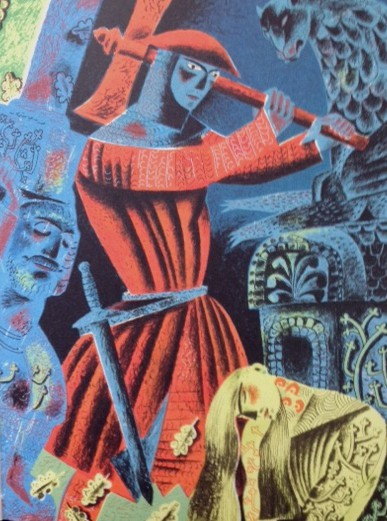Inspiring Older Readers
 posted on 17 May 2019
posted on 17 May 2019
Sir Gawain and the Green Knight translated by Simon Armitage and illustrated by Clive Hicks-Jenkins
Sir Gawain is an iconic Arthurian text, probably written in the late 14th century in what is now known as Middle English and by an author or authors unknown. It’s an extended poem of the chivalric tradition that draws on a whole range of other fragments from the British Isles and France.
The story revolves around the arrival of the mysterious Green Knight at the court of King Arthur where he issues a challenge to all and sundry – he will allow a knight to strike him unhindered with a sword or axe if, one year later, he is allowed to do the same in return. Gawain takes up the challenge and strikes off the Green Knight’s head only to see him pick up his head and ride off after reminding Gawain of the terms of the deal. The rest of the poem details Gawain’s quest to make good on his promise and to find the Green Knight so that he may return the blow.
I’m not going to detail the various encounters and adventures Gawain has along the way because, to be honest, that’s not why I was keen to review this particular edition and translation.
Perhaps unsurprisingly, the poem has been translated from Middle English into modern English by numerous poets and academics – including an important edition by J.R.R. Tolkien. Simon Armitage’s translation was first published in 2007 and it’s one I especially like because of the balance Armitage finds between formality and the colloquial. Academics who have spent years studying the poem and its use of language have concluded that whoever authored the work was probably from the north Midlands or that area we would now think of as ‘the north of England’ and this suits Armitage who finds his own use of a modern northern English vocabulary sympathetic to the task of translation.
But I’m interested here in showcasing this particular edition published in 2018 because of its fabulous illustrations by Clive Hicks-Jenkins. Welsh artist, Hicks-Jenkins, has a developed substantial reputation in the art world after focussing on painting following an earlier career in the theatre. The Wales Art Review described the illustrations as “camp, theatrical masterpieces” and went on to say:
“Hicks-Jenkins uses an array of effects, from collage-like layering, to bold imagistic statements, to mystical symbolism, to unfold the story in an arresting slideshow of technicolour shadow plays. Each scene ripples upon a deep pool of narrative and meaning. It is a powerful, kinetic, mesmerising exhibition.
The shadow puppet shapes of Hicks-Jenkins’ tableaux is not an affectation – he has frequently played with such two-dimensional landscapes – but rather there is a suggestion here that artist and subject matter have met and sparks have flown. There must be very few stories that have been blessed with the visualisation of so apt a vision.”
I was struck by the way these illustratiosn almost seemed like scenes from a Medieval tapestry - they somehow manage to be traditional and modern at one and the same time. I also see the influence of Edward Bawden in these drawings and that's by no means a criticism because this brings them into another strand of the British illustrative tradition.
The perfect combination of illustration and text make this edition from Faber an absolute dream to read and if you ever wanted an example of why a physical book is more than the sum total of paper, pen and ink then this is it.
You’ll also find it’s pretty modestly priced for something that is a real work of art – I’d buy another if I didn’t already have one.
Terry Potter
May 2019
(Click on any image below to view them in a slide-show format)




